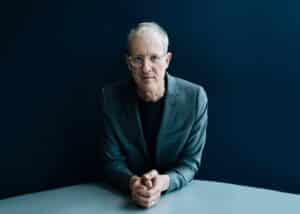
Jeff Speck has spent decades advocating for the benefits of dense and walkable environments. As cities confront the future of urban spaces in the post-pandemic era, he’s teaming up with transit advocate Chris Dempsey.
Jeff Speck
Title: Partner, Speck Dempsey
Age: 60
Industry experience: 30 years
Jeff Speck has spent decades advocating for the benefits of dense and walkable environments. As cities confront the future of urban spaces in the post-pandemic era, Speck recently teamed up with transit advocate and former state auditor candidate Chris Dempsey to combine their expertise in a new firm offering planning and transportation consulting to developers and municipalities. On the private sector side, the firm is advising Mark Development on its Riverside project in Newton and has been retained by The Davis Cos. as chief planning consultant on its redevelopment of the nearly 100-acre ExxonMobil tank farm in Everett. The firm also is participating in planning studies in Billerica, Hyannis and Worcester.
Q: What made this a good time to team up with Chris Dempsey?
A: I’d known Chris for years as a fellow Brookliner and a member of the transportation committee, when Brookline beat Boston to the punch and restriped Beacon Street to double the pedestrian and bicycling capacity in response to COVID. I got to know him through that process. I’d been running my business effectively as a sole proprietor since 2007, after I’d been design director at the National Endowment for the Arts, and started doing town planning projects and master plans. I managed to do 150 projects for 100 clients over 15 years, half for communities and half for developers, including the master plan for downtown Lowell that turned the one-way streets into two-way. I realized that my scope was really limited by staying a sole practitioner.
Q: What was your introduction to the New Urbanism movement?
A: It was 1989 when the father of New Urbanism, Andrés Duany, spoke at the Museum of Fine Arts and gave his classic talk about towns versus sprawl. I heard that and said, “This is the best story I’ve ever heard, and it needs to be a book.” We used to make great communities in the U.S., and no longer did. I joined [Duany’s] DPZ Co-Design for a decade as their director of town planning and we put on the first Congress for New Urbanism in 1993. The original talk that Andrew gave in 1989, we turned into the book, “Suburban Nation: The Rise of Sprawl and the Decline of the American Dream,” that came out in 2000 and was the best-selling planning title for that decade. I left after 10 years for the National Endowment for the Arts, and got to work with hundreds of mayors over four years and that led me to focus more on inner cities and write “Walkable City.” [Boston] Mayor Michelle Wu is one of the many people who read it, and she reached out to me as a city councilor.
Q: As a consultant to Bulfinch Triangle property owners who advocate for higher density, what is holding the neighborhood back?
A: It is an area that has an amazing location and incredible access to all forms of transportation. Is it very surprising to see how moribund the Bulfinch Triangle is. And it’s a function of zoning restrictions that have not allowed it to grow in a healthy way. We did our study to get the city excited about launching a proper planning effort to think about a rezoning that would preserve the Triangle’s character while allowing enough growth to allow it to come back to life. Between surface parking lots and empty storefronts, a major portion of the ground plane in the Bulfinch Triangle is empty. Other than South Station, there is no other place in Boston that’s receiving so many people on trains and buses. The proper plan with sensitive rezoning could allow the neighborhood to thrive and also maintain its historical character.
Q: What are your impressions of MBTA Communities law’s effects based upon the local response so far?
A: I think it will make a big difference. In a town like Brookline or Newton which historically has not built much housing in any given year, we’re going to see a much more visible uptick. Speck Dempsey is the lead urban designer for the Riverside project in Newton, which is slated to put more than 600 units of housing in that [MBTA] parking lot. That and Northland’s project [in Newton Upper Falls] are going to have a dramatic impact on Newton’s roster of attainable housing.
Q: What is the main focus of your work for municipalities?
A: The meat and potatoes of my work for the past 15 years has been a walkability study: figuring out how they can create an environment in which people will make the choice to work. There is a tremendous need in our urban and suburban centers for restriping streets like we did in Lowell and Hyannis and we’re going to do in Worcester, just to get cars to go the speed limit so pedestrians and cyclists are safe. One of the foundational aspects of our work is that here in the U.S., contrary to other places in the world, we have this bizarre circumstance where the typical urban street is designed for speeds that are well over our speed limits.
Jeff Speck’s Five Favorite Walkable Cities (This Week):
- Ljubljana, Slovenia
- Korcula, Croatia
- Kanazawa, Japan
- Antigua, Guatemala
- Rosemary Beach, Florida





